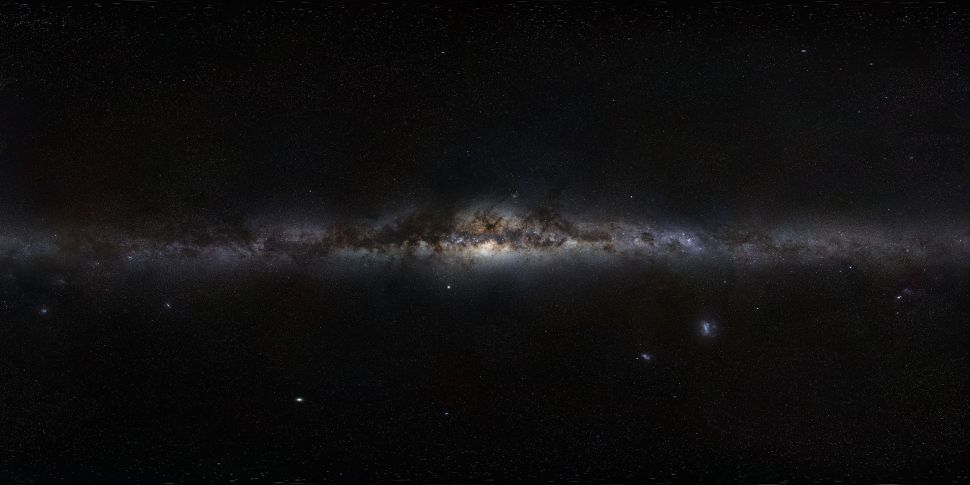19 Galaxies Are Apparently Missing Dark Matter. No One Knows Why.
Nineteen newly discovered dwarf galaxies seem to be missing their dark matter, and physicists aren't sure why.

Nineteen newly discovered dwarf galaxies seem to be missing their dark matter, and physicists aren't sure why.
The find dramatically increases the number of galaxies that appear to be missing dark matter, the mysterious, invisible stuff that exerts gravitational pull, yet emits no light. Dark matter is thought to be a key ingredient in galaxy formation, with its gravity pulling together atoms of gas to form galaxies. We can tell dark matter is present in a galaxy because it makes the matter in that galaxy swirl faster than it would if the matter we see made up the galaxy's whole mass. This faster swirling has shown up in every galaxy that could be precisely measured. Recently, however, researchers have found that certain small galaxies, now including these 19, behave as if they're dominated by baryons — the particles that make up ordinary matter. The evidence for their unseen halos of dark matter is missing.
Kyle Oman, an astrophysicist at Durham University in the United Kingdom, who wasn't involved in this discovery, said that these galaxies comprise the longest list of apparently dark matter-free objects yet reported. But they aren't the fist.
Related: The 11 Biggest Unanswered Questions About Dark Matter
The most widely reported discovery of a galaxy that seemed to lack dark matter came in March 2018. A team of astrophysicists led by Pieter van Dokkum, an astrophysicist at Yale University, showed that the average speed of globular clusters in galaxy NGC 1052–DF2 matched a baryons-only galaxy model, though many questioned the validity of the result, as Live Science reported.
Even as that story played out, however, additional teams found galaxies that seemed to lack dark matter. Those researchers used a different method, which singles out the motion of hydrogen atoms in a distant galaxy — the galaxy's "H1 rotation curves" — to show that the clouds of gas rotated as if they were not under the influence of dark matter. Oman worked on one such paper, which was published Sept. 25 in The Astrophysical Journal Letters.
The newest paper, published Nov. 25 in the journal Nature Astronomy, identified the 19 dark matter-free galaxies using the same method.
Get the Space.com Newsletter
Breaking space news, the latest updates on rocket launches, skywatching events and more!
"These H1 rotation curves are more accurate" than the method used by van Dokkum's team, said Till Sawala, an astrophysicist at the University of Helsinki. However, he said, there are still "systematic uncertainties" in the measurements that are yet to be resolved.
For instance, if the angle of the host galaxy relative to Earth is incorrectly measured, that can screw up the calculations, Oman said. And events like supernovas can speed up the gas in a normal galaxy, creating rotation curves that look from Earth like the galaxies in this new paper, Sawala said. Either way, more follow-up work is needed to confirm the dark matter-free claim, all the experts (including the study authors) said.
If it does turn out that certain galaxies do lack the normal amount of dark matter, however, that's a problem for current theories of how the universe formed.
Physicists explain how the universe formed and behaves using a model known as Lambda cold dark matter (ΛCDM). It describes three key features of the universe: the cosmological constant (Λ), dark matter and dark energy.
ΛCDM explains the way galaxies form, Sawala said, and it can't easily explain how these particular galaxies could have formed without dark matter.
Some of the examples that have turned up, Oman said, could be explained by the ΛCDM. For instance, dwarf galaxies in the middle of dense galaxy clusters have many other gravity sources around to strip away their dark matter. But in this paper, Oman said, some of the dark matter-free galaxies are solitary, far from any other gravity source.
"That's a challenge," Oman said.
Some researchers have presented the evidence of dark matter-free galaxies as the knockout punch in a battle between ΛCDM and another set of theories known as Modified Newtonian Dynamics (MOND). MOND theories reject dark matter in favor of tweaks to the physics of gravity. Since gravity should act everywhere in the universe, MOND would predict that what we call dark matter should also be everywhere, including every galaxy. But if these galaxies violate MOND, they violate ΛCDM as well, so it's not really a knockout punch to MOND, Sawala said.
Physicists said the only way to figure out what's going on is to study these galaxies in much more detail using different tools and confirm that what seems to be happening there is really happening.
- The 18 Biggest Unsolved Mysteries in Physics
- The Large Numbers That Define the Universe
- Twisted Physics: 7 Mind-Blowing Findings
Originally published on Live Science.

Join our Space Forums to keep talking space on the latest missions, night sky and more! And if you have a news tip, correction or comment, let us know at: community@space.com.

Rafi wrote for Live Science from 2017 until 2021, when he became a technical writer for IBM Quantum. He has a bachelor's degree in journalism from Northwestern University’s Medill School of journalism. You can find his past science reporting at Inverse, Business Insider and Popular Science, and his past photojournalism on the Flash90 wire service and in the pages of The Courier Post of southern New Jersey.










